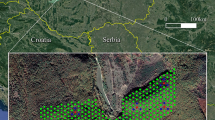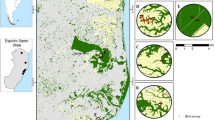Abstract
• Context
The Iberian cork oak Quercus suber montados are dynamic agro-silvo-pastoral systems, contrasting with the abandonment trend of other Mediterranean forested areas.
• Aims
We aimed to identify the effect of management type and vegetation features on breeding insectivorous birds and leaf-chewing defoliator insects.
• Methods
In central Portugal, we selected two groups of 20 sites: dense montados (DM, high cover of cork oaks and low cattle impact) and sparse montados (SM, low cover of oaks and high cattle impact). We collected variables associated with vegetation features, bird community and chewing defoliators.
• Results
The two systems differed significantly in oak trunk diameter, oak and shrub cover, tree and shrub diversity. Ground bird densities were higher in SM with fragmented shrub cover. In DM, higher woody vegetation cover and diversity can promote shrub birds and leaf warblers. Oak defoliation was mainly attributed to the sawfly Periclista andrei. Sawfly defoliation was significantly higher in SM and negatively correlated with shrub cover.
• Conclusions
Our results highlight (1) the relevance of management activities conducted at the shrubby layer, (2) the need of an increase in tree diversity and density and (3) the maintenance of a mosaic landscape in order to improve the bird community richness and reduce the defoliation impact in montado system.

Similar content being viewed by others
References
Baeta-Neves CML, Cabral MTC, Nogueira CDS, Ferreira LJC (1972) Bio-ecologia da Tortrix viridana L. e combate da Lymantria dispar L. pela luta biológica, Instituto Superior de Agronomia, Lisboa
Barriga JC, Lassaletta L, Moreno AG (2010) Ground-living spider assemblages from Mediterranean habitats under different management conditions. J Arachnol 38:258–269
Bengtsson J, Ahnstrom J, Weibull AC (2005) The effects of organic agriculture on biodiversity and abundance: a meta-analysis. J Appl Ecol 42:261–69
Bibby CJ, Burgess ND, Hill DA, Mustoe S (2000) Bird census techniques, 2nd edn. Academic, London
BirdLife International (2004) Birds in the European Union: a status assessment. Wageningen, BirdLife International, The Netherlands
Branco M, Ramos AP (2009) Coping with pests and diseases. In: Aronson J, Pereira JS, Pausas JG (eds) Cork Oak Woodlands: ecology, adaptive management, and restoration of an Ancient Mediterranean ecosystem. Island Press, Washington (DC), pp 103–111
Bugalho M, Plieninger T, Aronson J, Ellatifi H, Crespo DG (2009) Open woodlands: A diversity of uses (and overuses). In: Aronson J, Pereira JS, Pausas JG (eds) Cork Oak Woodlands: ecology, adaptive management, and restoration of an Ancient Mediterranean ecosystem. Island Press, Washington (DC), pp 33–45
Bugalho MN, Lecomte X, Gonçalves M, Caldeira MC, Branco M (2011) Establishing grazing and grazing-excluded patches increases plant and invertebrate diversity in a Mediterranean oak woodland. Forest Ecol Manag 261:2133–2139
Butler SJ, Boccaccio L, Gregory RD, Vorisek P, Norris K (2010) Quantifying the impact of land-use change to European farmland bird populations. Agric Ecosyst Environ 137:348–357
Camprodon J, Brotons L (2006) Effects of undergrowth clearing on the bird communities of the Northwestern Mediterranean Coppice Holm oak forests. Forest Ecol Manag 221:72–82
Carrascal LM, Alonso CL (2006) Habitat use under latent predation risk. A case study with wintering forest birds. Oikos 112:51–62
Correia OA (2002) Os cistus: As especies do futuro? In: Loução MA (ed) Fragmentos de ecologia. Escolar Editora, Lisboa, pp 97–119
Costa A, Madeira M, Oliveira AC (2008) The relationship between cork oak growth patterns and soil, slope and drainage in a cork oak woodland in Southern Portugal. Forest Ecol Manag 255:1525–1535
Dulaurent AM, Porté AJ, van Halder I, Vétillard F, Menassieu P, Jactel H (2011) A case of habitat complementation in forest pests: pine processionary moth pupae survive better in open areas. Forest Ecol Manag 261:1069–1076
Ferreira MC, Ferreira GWS (1991) Pragas das folhosas. Guia de campo n.º 4, DGPA, Lisboa
Forker RE, Marquis RJ, Lill JT (2004) Feeny revisited: condensed tannins as antiherbivore defences in leaf-chewing herbivore communities of Quercus. Ecol Entomol 29:174–187
Godinho C, Rabaça JE (2011) Birds like it corky: the influence of habitat features and management of ‘montados’ in breeding bird communities. Agroforest Syst 82:183–195
Herrera CM (1984) A study of avian frugivores, bird-dispersed plants, and their interaction in Mediterranean scrublands. Ecol Monogr 54:1–23
SPSS Inc, 2007. SPSS 16.0 for Windows, Chicago, IL
Jactel H, Brockerho VEG (2007) Tree diversity reduces herbivory by forest insects. Ecol Lett 10:835–848
Kalapanida M, Petrakis P (2012) Temporal partitioning in an assemblage of insect defoliators feeding on oak on a Mediterranean mountain. Eur J Entomol 109:55–69
Leiva MJ, Fernández-Alés R (2005) Holm-oak (Quercus ilex subs. ballota) acorns infestation by insects in Mediterranean dehesas and shrublands. Its effect on acorn germination and seedling emergence. Forest Ecol Manag 212:221–229
Luciano P, Roversi PF (2001) Oak defoliators in Italy. Edizioni Poddighe Sassari, Sassari
Marañon T (1986) Plant species richness and canopy effect in the savanna like ‘dehesa’ of S.W. Spain. Ecol Mediterr 12:131–141
Marquis RJ, Whelan CJ (1994) Insectivorous birds increase growth of white oak through consumption of leaf-chewing insects. Ecol 75:2007–2014
Martins da Silva P, Aguiar CAS, Niemelä J, Sousa JP, Serrano ARM (2008) Diversity patterns of ground beetles (Coleoptera: Carabidae) along a gradient of land-use disturbance. Agric Ecosyst Environ 124:270–274
Murakami M, Nakano S (2000) Species-specific bird functions in a forest-canopy food web. Proc R Soc London B 267:1597–1601
Pinto-Correia T, Mascarenhas J (1999) Contribution to the extensification/intensification debate: new trends in the Portuguese montado. Landsc Urban Plan 46:125–131
Pulido FJ, Díaz M (1992) Relaciones entre la estructura de la vegetación y las comunidades de aves nidificantes en las dehesas: influencia del manejo humano. Ardeola 39:63–72
Roland J, Taylor P, Cooke B (1997) Forest structure and the spatial pattern of parasitoid attack. In: Watt AD, Stork NE, Hunter MD (eds) Forests and insects. Chapman & Hall, London, pp 97–106
Rubtsov VV (1996) Influence of repeated defoliations by insects on wood increment in common oak (Quercus robur L.). Ann For Sci 53:407–412
Sanz JJ (2001) Experimentally increased insectivorous bird density results in a reduction of caterpillar density and leaf damage to Pyrenean oak. Ecol Res 16:387–394
Scarascia-Mugnozza G, Oswald H, Piussi P, Radoglou K (2000) Forests of the Mediterranean region: gaps in knowledge and research needs. Forest Ecol Manag 132:97–109
Skuhravý V, Hrubík P, Skuhravá M, Pożgaj J (1998) Occurrence of insects associated with nine Quercus species (Fagaceae) in cultured plantations in southern Slovakia during 1987–1992. J Appl Entomol 122:149–155
Smit C, Díaz M, Jansen P (2009) Establishment limitation of holm oak (Quercus ilex subsp. ballota (Desf.) Samp.) in a Mediterranean savanna—forest ecosystem. Ann For Sci 66:511–517
Smith DR (2006) List of the sawflies (Hymenoptera: Symphyta) of Virginia. Banisteria 28:3–23
Snow DW, Perrins CM (1998) The birds of the Western Palearctic. Concise edition, vol 1–2. Oxford University Press, Oxford
Southwood TRE, Wint GRW, Kennedy CEJ, Greenwood SR (2004) Seasonality, abundance, species richness and specificity of the phytophagous guild of insects on oak (Quercus) canopies. Eur J Entomol 101:43–50
Strubbe D, Matthysen E (2009) Experimental evidence for nest-site competition between invasive Ring-necked Parakeets (Psittacula krameri) and native Nuthatches (Sitta europaea). Biol Conserv 142:1588–1594
Tellería JL (2001) Passerine bird communities of Iberian dehesas: a review. Anim Biodivers Conserv 24:67–78
Acknowledgments
We are grateful to Eng. Rui Alves (Forestry and Natural Resources Department, Companhia das Lezírias S.A.) for all logistic support. We appreciated the comments and suggestions of fellow researchers, which helped to improve the scientific value of the study: Rita Azedo, Sara Santos, Pedro Salgueiro and Rui Lourenço. The authors are thankful to two anonymous referees for their valuable comments and suggestions to an earlier version of the manuscript.
Funding
This study was totally funded by Companhia das Lezírias S.A. under the European Business and Biodiversity initiative (project designation: CL/UE-B&B2008/12—Biodiversity Valorisation of Companhia das Lezírias).
Author information
Authors and Affiliations
Corresponding author
Additional information
Handling Editor: Francois Lieutier
Contribution of the co-authors
Pedro Pereira designed the experiment, conducted field work, data analysis and manuscript writing. Carlos Godinho designed the experiment, conducted field work and manuscript reviewing. Inês Roque designed the experiment and manuscript reviewing. Ana Marques reviewed the manuscript. Manuela Branco designed the experiment and reviewed the manuscript. João Eduardo Rabaça designed the experiment, coordinated the research project and reviewed the manuscript.
Rights and permissions
About this article
Cite this article
Pereira, P., Godinho, C., Roque, I. et al. Time to rethink the management intensity in a Mediterranean oak woodland: the response of insectivorous birds and leaf-chewing defoliators as key groups in the forest ecosystem. Annals of Forest Science 71, 25–32 (2014). https://doi.org/10.1007/s13595-012-0227-y
Received:
Accepted:
Published:
Issue Date:
DOI: https://doi.org/10.1007/s13595-012-0227-y




